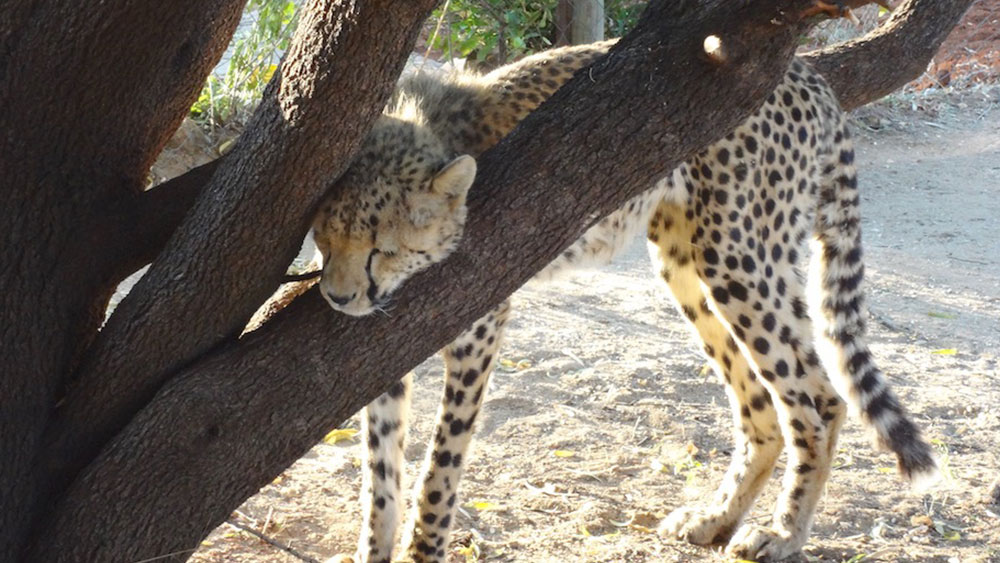How Cheetahs Check Their Messages?
-

- by Meredith Hanel May 11, 2020

Most of us start our day by reading the news and checking our messages. In newsfeeds and messages can help us decide things like what route to take to work or make plans to meet up with a friend for lunch. Dogs, our four-legged friends, read their messages with their noses, and there are always certain patches of grass, or special trees where they want to leave messages of their own. Many of the scent marking behaviours that dogs exhibit are exhibited by cheetahs and other animals in the wild. In addition to depositing ‘number one (urine)’ and ‘number two (scat)’, cheetah scent-marking also includes rubbing their cheek or body against a tree or raking their hind feet on the site they left their mark.
Cheetahs leave scents on trees, termite mounds and man-made objects that stand out in the landscape. Certain scent-marking sites are popular and are repeatedly used, becoming important hubs of communication among cheetahs. Scent messages let them know about other cheetahs in the territory. Are they dominant males? Are they females that want to mate? We may use hashtags as a strategy on social media to have our message seen by more people. Cheetahs have criteria for choosing the right tree on which to leave a message so that their scent-based communication gets maximum ‘engagement’. Those criteria were investigated by CCF researchers using camera traps and they found that the two most important criteria for choosing a tree for scent marking were that the trees had a large enough stem circumference for them to climb into and that the tree was highly visible. Cheetahs have good reason to be choosy about their scent marking since this communication allows cheetahs to share space with fewer aggressive encounters.
Meeting Up With Friends
Instead of text messages, cheetahs likely use scent messages to find their friends. Male cheetahs often maintain close associations with their brothers called coalitions. These male cheetahs do have a limited time apart. Researchers wondered how these friends are able to find each other. In order to gain some insight, they recorded the GPS positions of three males in a coalition over 6.5 months and also monitored the area with camera traps.
One male cheetah separated from his two coalition partners for a period of 31 days. The three buddies reunited after the lone male cheetah crossed the trail of the other two within 2.4 hours of the other group who were hanging out in that area. The researchers observed that the lone male cheetah walked in a looping pattern, that may have been triggered by catching the scent of his friends. Based on the amount of range used during the separation there was only a small chance they found each other by chance alone and the location where they reunited was an area not frequently travelled. The researchers believe that coincidence of being somewhat in the same area played a part in the reunion but that the picking up of scent marks and perhaps vocalizations most probably helped them find each other.
Interspecific Communication
Scent marking is important for communication between cheetahs, called intraspecific communication. But do cheetahs’ and other predators read each other’s messages? Interspecific communication through scent marking is a relatively new area of research that has become more common now thanks to the availability of camera traps to collect data. In Canada, shared “communication trees” are found to be scent marked by wolves, coyotes, red foxes, lynx, pumas, grizzly bears, black bears, wolverines, martens and domestic dogs. In Botswana, slender mongooses and small-spotted genets have been observed to mark at cheetah scent-marking trees. Observations of cheetahs and other carnivores countermarking on top of scent marks of other carnivore species suggests there is information flowing across species.
Communication Interference
Recently researchers wondered if the presence of other predators had an influence on cheetah message-leaving behaviour. Male cheetahs took longer to return to sites that had been visited by lions and leopards compared with sites that have been visited by spotted hyenas and African wild dogs. Female cheetahs did not even visit scent-marking sites when scents of other large predators were present or experimentally provided. The study revealed that other carnivores in cheetah territory could potentially inhibit breeding through blocking the female cheetahs in estrous from communicating their status to male cheetahs in the area. Cheetahs use multiple closely spaced scent-marking sites, a behaviour that may allow them to keep their lines of communication open in a territory shared with dominant predators.
References
Apps, P., Rafiq, K., & McNutt, J. W. (2019). Do Carnivores Have a World Wide Web of Interspecific Scent Signals? In Chemical Signals in Vertebrates.
Cornhill, K. L., & Kerley, G. I. H. (2020). Cheetah communication at scent-marking sites can be inhibited or delayed by predators. Behavioral Ecology and Sociobiology, 74(2). doi: 10.1007/s00265-020-2802-9
Hubel, T. Y., Shotton, J., Wilshin, S. D., Horgan, J., Klein, R., Mckenna, R., & Wilson, A. M. (2016). Cheetah Reunion – The Challenge of Finding Your Friends Again. Plos One, 11(12). doi: 10.1371/journal.pone.0166864
Walker, E.H., Nghikembua, M., Bibles, B. and Marker, L. (2016) Scent-post preference of free-ranging Namibian cheetahs. Global Ecology and Conservation, 8: 55-57. https://doi.org/10.1016/j.gecco.2016.08.007
Related Reading
-
June 1, 2020
Two Trainings at CCF -
March 18, 2020
For the First Time CCF Closes its Doors to Visitors




